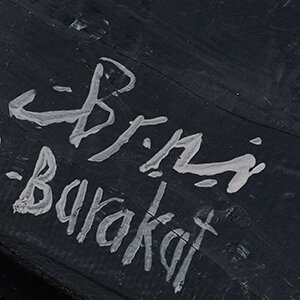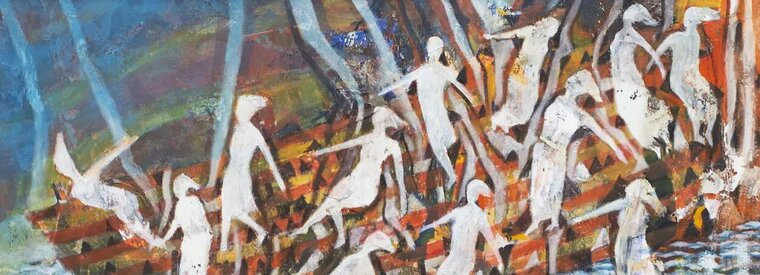


Last updated on Wed 15 January, 2020


SHORELESS SEA BY TAYSEER BARAKAT
15 January – 15 June 2020
Zawyeh Gallery, Ramallah
This is not an ordinary sea; this is a shoreless sea. Here swimming doesn’t end and drowning is possible as well as separation from the loved ones. Waves rise and clash fiercely, helicopters pass over boats and refugees flee from bloody wars. Stolen intimate moments amid an atmosphere full of panic and hope is still possible.
In Shoreless Sea, Tayseer Barakat’s works manifest as an account on refugees’ desperate journeys to cross the Mediterranean to Europe in search for a normal life. For Barakat, the Mediterranean was part of his life; he himself is a refugee who lived near the shores of Gaza as a child and by the shores of Alexandria as an undergraduate student. Yet, the Sea became colder since then. It also became merciless and its appetite grew stronger. Suddenly, it hid its beaches, leaving people on board to wander in desperate search of ways to escape.
The drawing technique Barakat uses creates a real feeling of moving waves, turbulent water and an alive sea. Looking closely, one could imagine Poseidon, the Greek god of the Sea, steering sea-storms and creating enormous waves across the surface. One can even feel him breathing from under the waters through the lungs of hundreds of refugees who lost their lives drowning in the depths.
A boat throws those on board in the sea, souls flying in the skies, rescue missions, a mother holding her children tightly, two lovers, border patrols, a helicopter flying overheads … heroic journeys culminate in a line of detained refugees walking to an unknown destination… one can also imagine what looks like ceremonial rituals with the participation of the few who managed to pass all the obstacles on the way.
In a series of large paintings titled “Separation”, the color of white dominates, reflecting the coldness of the sea and the world’s indifference to the refugees’ plight. In one painting, two figures appear from the sides of one painting separated by a vast area of white. In another, sea foam takes the form of unspoken words of those who perished in the sea… farewells in moments of forced separation, and survivors searching for what remains. In the midst of all of this, women are the focal point in these scenes; a woman puts her hands behind her back in a state of waiting and anticipation, another colored in orange attempts to break the coldness of the white surface with the warmth of her flying body; a bride stands near the sea and another looks into a mirror, is she the next sacrifice to sate the god of the sea?

Tayseer Barakat, Shoreless Sea #6, 2019, acrylic on canvas, 70 x 50 cm

Tayseer Barakat, Shoreless Sea #7, 2019, acrylic on canvas, 70 x 50 cm

Tayseer Barakat, Shoreless Sea #9, 2019, acrylic on canvas, 70 x 50 cm

Tayseer Barakat, Shoreless Sea #13, 2019, acrylic on canvas, 70 x 50 cm

Tayseer Barakat, Shoreless Sea #14, 2019, acrylic on canvas, 47 x 42 cm

Tayseer Barakat, Shoreless Sea #15, 2019, acrylic on canvas, 70 x 50 cm

Tayseer Barakat, Shoreless Sea #16, 2019, acrylic on canvas, 47 x 42 cm

Tayseer Barakat, Shoreless Sea #38, 2019, acrylic on canvas, 60 x 75 cm

Tayseer Barakat, Shoreless Sea #40, 2019, acrylic on canvas, 50 x 70 cm

Tayseer Barakat, Shoreless Sea #39, 2019, acrylic on canvas, 47 x 41 cm

Tayseer Barakat, Shoreless Sea #20, 2019, acrylic on canvas, 50 x 70 cm

Tayseer Barakat, Unknown #10, 2018, acrylic on canvas, 31 x 27 cm
Tayseer Barakat was born in Gaza in 1959 and completed his arts education in Alexandria, Egypt, in 1983. After completing his studies, he moved to Ramallah where he has since based – both teaching and creating art. Barakat has worked with a variety media and has experimented widely – with wood, metal and glass – and has become one of Palestine’s foremost artists working today. Painting remains his first love and he continues to work at a prolific rate, drawing on the artistic heritage of the region and its ancient influences.
Tayseer Barakat is one of Palestine’s prominent artists whose practice has drawn inspiration from the ancient past and from the oral traditions and cultural narratives that are intimately tied to life in Palestine. Working primarily in paint, inks, and dyes, he uses a color palette that is often limited to monochrome tones, which imbues his works with a certain soberness. In Barakat’s words, the dark colors he uses “reflect the hardships of our time and our present life. I think the pressure on us makes us use dark colors.”
His solo exhibitions included Sao Paulo Biennale, Sao Paulo, Brazil in 1996, The Number that Became a Name, Ramallah in 2006 and Distant Voices – Zawyeh Gallery, Ramallah in 2014. In addition, he has held 10 solo exhibitions and has participated in numerous group exhibitions with many of his contemporaries in Japan, USA, Brazil, Europe and across the Arab world.
Join us in our endless discovery of modern and contemporary Arab art